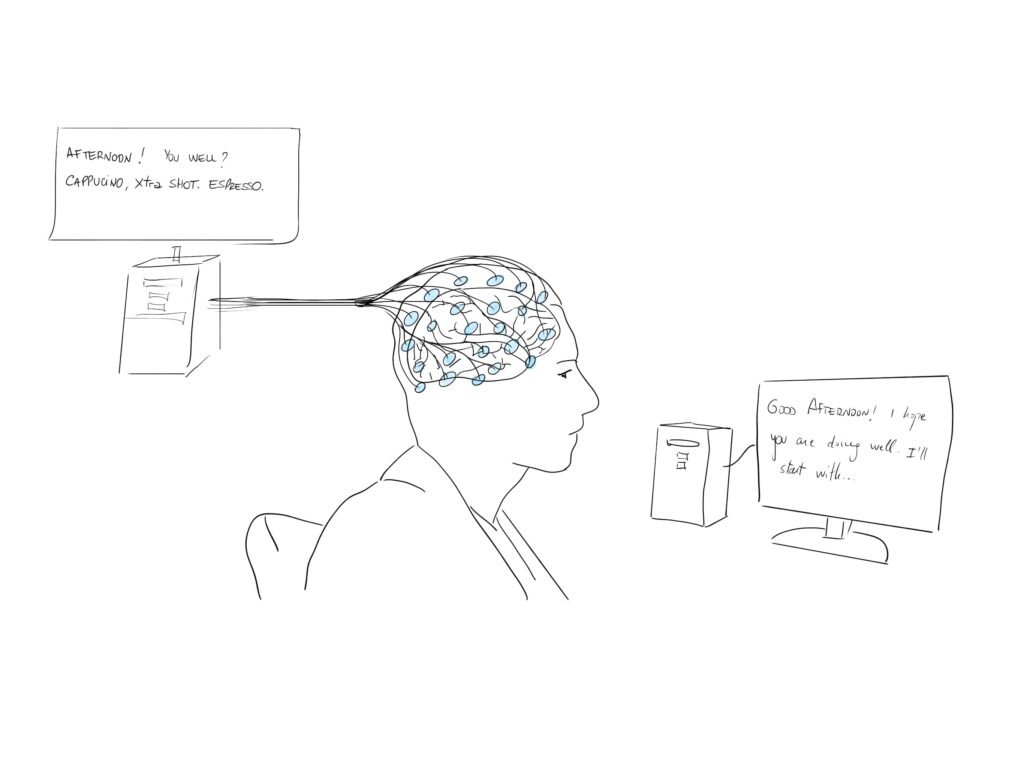Reading minds may no longer be limited to sci-fi movies. A group of scientists from the University of Technology of Sidney built a revolutionary helmet that can read the wearer’s mind. The helmet can read brain waves and turn them into words through AI technology.
How does it work?
The helmet is made of tens of sensors. Each sensor detects electrical activity in different parts of your brain.
Because our neurons “talk to each other” through electrical signals, the sensor can translate brain activity into words.
To prove how it worked, they gathered 29 volunteers. Each of them was shown a sentence on a screen and was asked to read it. Meanwhile, they were wearing the helmet. The AI model then translated the stimuli into words and showed a text.
In their presentation, one of the participants read the following sentence: ‘Good afternoon! I hope you’re doing well. I’ll start with a cappuccino, please, with an extra shot of espresso.’
The AI machine showed the text: ‘Afternoon! You well? Cappuccino, Xtra shot. Espresso.’

Even though the words are not 100% accurate, they convey the same message. In their study, the AI got a 40% accuracy rate. Professor Chin-Teng Lin, the leading researcher, says it can go up to 90% if they keep working and iterating the algorithm.
If you think about it, this is pretty amazing.
So, isn’t this dangerous?
Reading your thoughts? It’s pretty terrifying, isn’t it?
Even our thoughts won’t be secret anymore? Who would want to risk getting their brain read? This is going to look like the 1984 novel.
Well, the good news is you need to actually wear the helmet. Otherwise, it won’t work. For the moment, it doesn’t seem like anybody is going to read your mind while you walk along the street. Your brainwaves are too tiny to be detected from a distance.
What good could it do?
Even though it looks scary, it could be extremely helpful in some cases.
For example, imagine you are mute due to a stroke or you have locked-in syndrome or paralysis after a spine injury.
In those cases, your brain cannot communicate with your mouth or your limbs.
If a machine can read your mind, it will be able to send your orders to a microphone or a bionic limb. That way, you could be able to talk again and walk again.
Of course, this is not the first time that somebody has tried it. You may have heard of Elon Musk’s Neuralink.
In Neuralink they are trying to achieve the same goal, but their method involves inserting a chip inside your brain. That requires brain surgery, which carries some risks, like a stroke or an infection.
Other scientists have tried the same while using an MRI, but the results were not as good (and also you had to stay still inside an MRI for a few minutes, not very convenient).
This helmet, on the other side, is cheap, simple, and easily transportable.
Some final thoughts
Some final thoughts
It’s inevitable to start thinking about the ethics of mind-reading technology.
Our thoughts and feelings are our most private possessions. If somebody would be able to steal them from us, it would be over. Our freedom would be over.
Privacy and consent must be central in any regulation regarding this type of technology.
Also, we need to temper our expectations. For the moment, the accuracy rate was 40%. It may go up to 90%, but is that enough? Even though that seems like a high number, it means 10% of the message will not be correct. If we were using the technology to drive a bionic limb, a 10% error could mean falling down the stairs, or worse.
Anyway, I hope you enjoyed the post; let me know what you think about it in the comments!
Leave a Reply